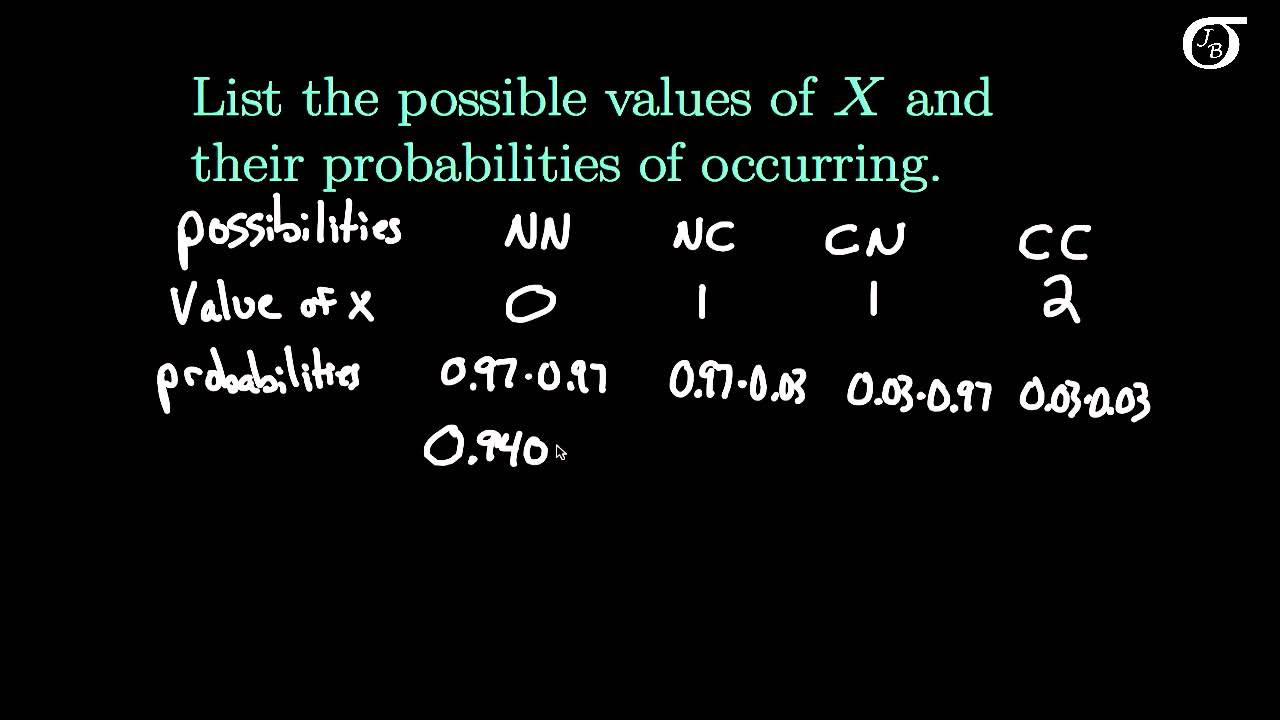Introduction to Random Variables
TLDRThis script introduces the concept of random variables, which are functions mapping random processes to numerical values, rather than unknowns in equations. It distinguishes between discrete and continuous random variables, using examples like coin flips and dice rolls for the former, and rainfall measurement for the latter. The explanation emphasizes the importance of understanding random variables in probability distributions and expected values, setting the stage for further discussions on various distributions like uniform, binomial, and the normal distribution.
Takeaways
- 🧑🏫 The concept of a random variable is introduced as a function that maps outcomes of random processes to numbers, rather than an unknown in an equation.
- 🔤 Random variables are typically denoted by capital letters such as X, Y, or Z to distinguish them from traditional variables.
- 🎲 Random variables can take on multiple values, but unlike traditional variables, we do not solve for them; they are used to quantify random processes.
- 🌧️ An example given is a random variable for rain, where it equals 1 if it rains and 0 if it does not, illustrating the mapping of a random process to a numerical outcome.
- 🎯 Random variables can be discrete, with a finite number of outcomes, or continuous, allowing for an infinite range of possible values.
- 🎲 Examples of discrete random variables include the outcomes of flipping a coin or rolling a die, each with a finite set of possible results.
- 🌊 An example of a continuous random variable is the amount of rain in inches, which can take on any value within a range, representing an infinite number of possibilities.
- 📊 Probability distributions are used to represent the likelihood of different outcomes for random variables, often visualized as histograms or bar charts.
- 🎯 Discrete random variables have probability distributions that can be represented as a series of bars, each corresponding to a possible outcome and its probability.
- 📈 The script contrasts uniform distributions, where all outcomes are equally likely, with non-uniform distributions that have varying probabilities for different outcomes.
- 📚 The importance of understanding random variables and probability distributions is highlighted for further study in statistics, including concepts like expected values and different types of distributions.
Q & A
What is a random variable and why might its name be misleading?
-A random variable is a function that maps outcomes of random processes to actual numbers. Its name might be misleading because it suggests variability in the traditional sense of an unknown in an equation, which you can solve for, whereas a random variable is not something you solve for but rather a function that assigns values to random outcomes.
How is a random variable typically denoted in mathematical notation?
-A random variable is usually denoted by a capital letter, often X, Y, or Z, to distinguish it from traditional variables.
What is the difference between a discrete random variable and a continuous random variable?
-A discrete random variable can take on a finite or countably infinite number of distinct values, such as the outcomes of a coin flip or a die roll. A continuous random variable, on the other hand, can take on an infinite number of values within a range, like the amount of rain in inches.
Can you provide an example of a discrete random variable?
-An example of a discrete random variable is the outcome of a coin flip, which can result in either heads (1) or tails (0), or the number facing up when rolling a fair six-sided die, which can be any number from 1 to 6.
What is an example of a continuous random variable mentioned in the script?
-An example of a continuous random variable given in the script is the exact amount of rain in inches that may fall tomorrow.
How are the probabilities of different outcomes represented for a discrete random variable?
-For a discrete random variable, the probabilities of different outcomes are represented by a probability distribution, often depicted as a bar chart or histogram, where each outcome is listed on the horizontal axis and the corresponding probability is on the vertical axis.
What is a uniform distribution and how can it be identified in a probability distribution?
-A uniform distribution is a type of probability distribution where all outcomes are equally likely to occur. It can be identified in a probability distribution by observing that all outcomes have the same probability, resulting in bars of equal height in a histogram representation.
How does the probability distribution of an unfair dice differ from that of a fair dice?
-The probability distribution of an unfair dice differs from that of a fair dice in that the probabilities of the outcomes are not equal. For example, one outcome may have a higher chance of occurring than others, or some outcomes may be impossible, as illustrated in the script with a dice that has two sixes and no twos.
What is the probability of rolling a 6 on the described unfair dice with two sixes?
-The probability of rolling a 6 on the described unfair dice is 2/6, which simplifies to 1/3, because there are two sixes out of a total of six possible outcomes.
How can you determine the probability of a random variable being greater than or equal to a certain value using its probability distribution?
-To determine the probability of a random variable being greater than or equal to a certain value, you sum the probabilities of all outcomes that meet or exceed that value. For example, if you want to find the probability that the random variable x (representing the number on a die) is greater than or equal to 5, you would add the probabilities of the outcomes that are 5 and 6.
What is the significance of random variables in understanding and working with probability distributions and expected values?
-Random variables are significant in understanding and working with probability distributions and expected values because they provide a way to quantify and assign numerical values to the outcomes of random processes. This quantification allows for the calculation of probabilities, expected values, and other statistical measures that are essential for analyzing and making predictions based on random phenomena.
Outlines
🔢 Introduction to Random Variables
The first paragraph introduces the concept of a random variable, which is a function mapping from a random process to a numerical value. It explains that unlike traditional variables that can be solved for, random variables are not solved but instead take on multiple values. The speaker clarifies the confusion caused by the term 'variable' and emphasizes that a random variable is more akin to a function. Examples given include whether it will rain tomorrow, where the random variable can be 1 for rain and 0 for no rain, and rolling a die, where the random variable is the number facing up. The paragraph also distinguishes between discrete and continuous random variables, with the former having a finite number of outcomes and the latter having an infinite number of possible outcomes.
📊 Understanding Probability Distributions
The second paragraph delves into the concept of probability distributions for discrete random variables. It uses the example of rolling a fair die to illustrate a uniform distribution, where each outcome (1 through 6) has an equal probability of 1/6. The paragraph then contrasts this with a non-uniform distribution, where the probabilities of different outcomes vary. An example of an unfair die is given, where the outcomes have different probabilities, such as a 6 being twice as likely as the other numbers. The speaker explains how to interpret probability distribution functions to determine the likelihood of various outcomes, setting the stage for discussions on continuous probability distributions and probability density functions in future videos.
📚 Transition to Continuous Probability Distributions
The third paragraph serves as a transition, indicating that future videos will explore continuous probability distributions, known as probability density functions. It mentions that while the current discussion has focused on discrete random variables, upcoming content will cover distributions that are more complex and often observed in nature, such as the uniform distribution, binomial distribution, and the normal distribution, also known as the Gaussian or bell curve. The speaker hints at the relevance of these distributions in various natural phenomena and expresses a temporary conclusion to the current topic, promising to continue the discussion in the next video.
Mindmap
Keywords
💡Random Variable
💡Variable
💡Probability Distribution
💡Discrete Random Variable
💡Continuous Random Variable
💡Uniform Distribution
💡Probability Density Function (PDF)
💡Expected Value
💡Binomial Distribution
💡Normal Distribution
Highlights
Introduction to the concept of a random variable.
Random variables are often misunderstood due to their name, which suggests they are similar to traditional variables.
Random variables can take on multiple values but are not solved for, unlike traditional variables.
Notation for random variables typically uses capital letters like X, Y, or Z.
Random variables are functions that map random processes to actual numbers.
Example given: a random variable for rain tomorrow, where 1 represents rain and 0 represents no rain.
Random variables can be assigned different numbers to represent outcomes, such as 21 and 100.
The importance of distinguishing random variables from traditional variables in terms of their function.
Random variables can represent outcomes of experiments, like heads or tails in a coin flip.
The concept of probability distributions and expected values will be discussed using random variables.
There are two types of random variables: discrete and continuous.
Discrete random variables have a finite number of outcomes, like coin flips or dice rolls.
Continuous random variables can take on an infinite number of outcomes, such as the amount of rain in inches.
Explanation of how continuous random variables differ from discrete ones in terms of probability distributions.
Probability distribution of a fair dice roll is demonstrated with a uniform distribution example.
Non-uniform probability distribution example given with an unfair dice having altered probabilities for each face.
The ability to determine probabilities of different events from a given probability distribution function.
Upcoming discussion on continuous probability distributions known as probability density functions.
Introduction to common probability distributions found in nature, such as the uniform, binomial, and normal distributions.
Transcripts
Browse More Related Video

Session 40 - Probability Distribution Functions - PDF, PMF & CDF | DSMP 2023

Introduction to Discrete Random Variables and Discrete Probability Distributions

02 - Random Variables and Discrete Probability Distributions

Elementary Stats Lesson #9

5. Discrete Random Variables I

5.1.1 Discrete Probability Distributions - Discrete and Continuous Random Variables
5.0 / 5 (0 votes)
Thanks for rating: